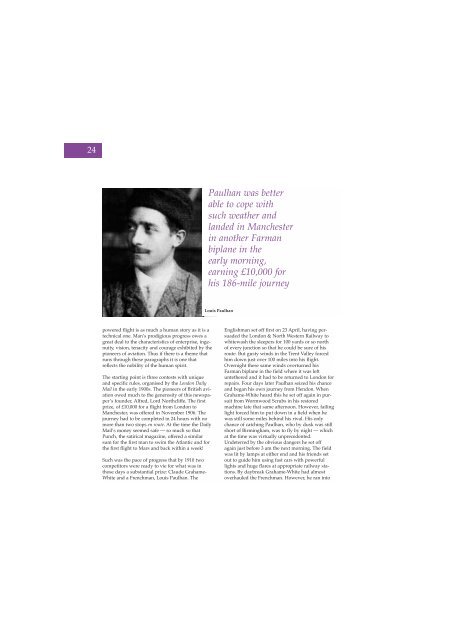Volume 6 No 4 - Royal Air Force Centre for Air Power Studies
Volume 6 No 4 - Royal Air Force Centre for Air Power Studies
Volume 6 No 4 - Royal Air Force Centre for Air Power Studies
Create successful ePaper yourself
Turn your PDF publications into a flip-book with our unique Google optimized e-Paper software.
24<br />
Paulhan was better<br />
able to cope with<br />
such weather and<br />
landed in Manchester<br />
in another Farman<br />
biplane in the<br />
early morning,<br />
earning £10,000 <strong>for</strong><br />
his 186-mile journey<br />
Louis Paulhan<br />
powered flight is as much a human story as it is a<br />
technical one. Man’s prodigious progress owes a<br />
great deal to the characteristics of enterprise, ingenuity,<br />
vision, tenacity and courage exhibited by the<br />
pioneers of aviation. Thus if there is a theme that<br />
runs through these paragraphs it is one that<br />
reflects the nobility of the human spirit.<br />
The starting point is three contests with unique<br />
and specific rules, organised by the London Daily<br />
Mail in the early 1900s. The pioneers of British aviation<br />
owed much to the generosity of this newspaper’s<br />
founder, Alfred, Lord <strong>No</strong>rthcliffe. The first<br />
prize, of £10,000 <strong>for</strong> a flight from London to<br />
Manchester, was offered in <strong>No</strong>vember 1906. The<br />
journey had to be completed in 24 hours with no<br />
more than two stops en route. At the time the Daily<br />
Mail’s money seemed safe — so much so that<br />
Punch, the satirical magazine, offered a similar<br />
sum <strong>for</strong> the first man to swim the Atlantic and <strong>for</strong><br />
the first flight to Mars and back within a week!<br />
Such was the pace of progress that by 1910 two<br />
competitors were ready to vie <strong>for</strong> what was in<br />
those days a substantial prize: Claude Grahame-<br />
White and a Frenchman, Louis Paulhan. The<br />
Englishman set off first on 23 April, having persuaded<br />
the London & <strong>No</strong>rth Western Railway to<br />
whitewash the sleepers <strong>for</strong> 100 yards or so north<br />
of every junction so that he could be sure of his<br />
route. But gusty winds in the Trent Valley <strong>for</strong>ced<br />
him down just over 100 miles into his flight.<br />
Overnight these same winds overturned his<br />
Farman biplane in the field where it was left<br />
untethered and it had to be returned to London <strong>for</strong><br />
repairs. Four days later Paulhan seized his chance<br />
and began his own journey from Hendon. When<br />
Grahame-White heard this he set off again in pursuit<br />
from Wormwood Scrubs in his restored<br />
machine late that same afternoon. However, failing<br />
light <strong>for</strong>ced him to put down in a field when he<br />
was still some miles behind his rival. His only<br />
chance of catching Paulhan, who by dusk was still<br />
short of Birmingham, was to fly by night — which<br />
at the time was virtually unprecedented.<br />
Undeterred by the obvious dangers he set off<br />
again just be<strong>for</strong>e 3 am the next morning. The field<br />
was lit by lamps at either end and his friends set<br />
out to guide him using fast cars with powerful<br />
lights and huge flares at appropriate railway stations.<br />
By daybreak Grahame-White had almost<br />
overhauled the Frenchman. However, he ran into
















